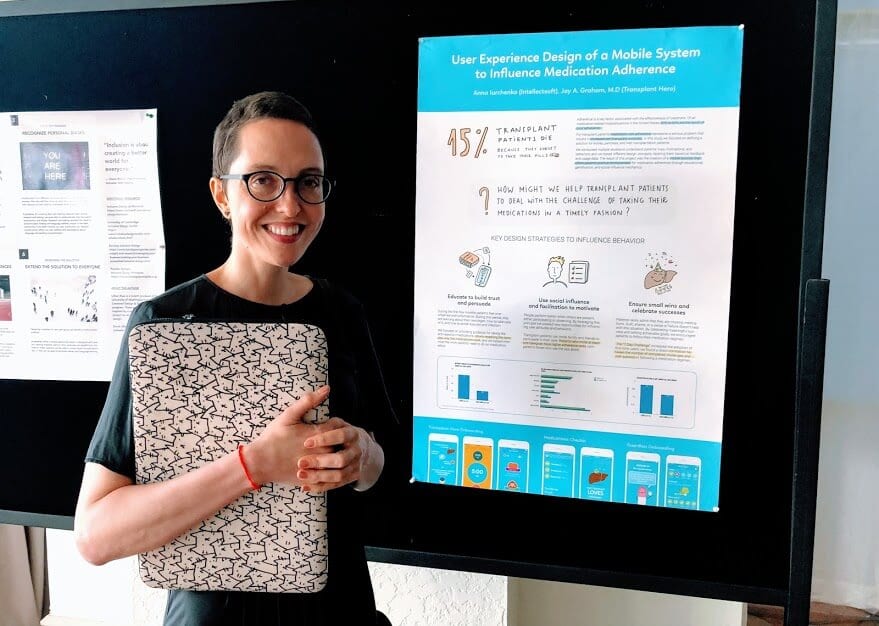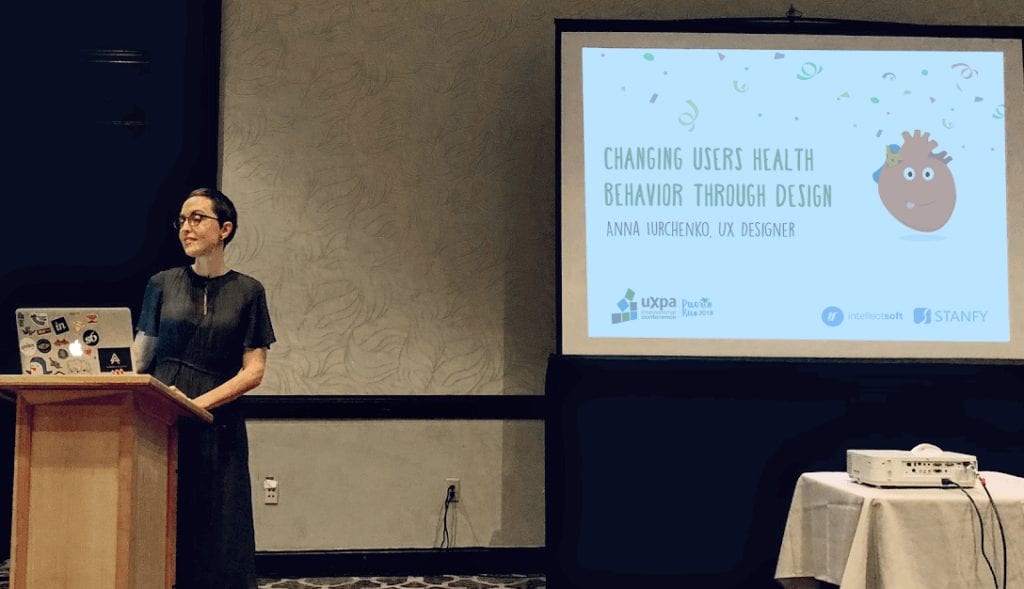Modern tech conferences begin with yoga sessions at the beach. Several years ago a start like this might have been common only to small to medium conferences, where ninety percent of participants are startups. Today, the trend has reached the most anticipated event in the user experience field — UXPA international 2018, which took place in Puerto Rico at Wyndham Rio Mar beach resort on 26-28 of June.
Intellectsoft flew to the picturesque lands of the island as well: Anna Iurchenko, the experience designer of Intellectsoft Augmented Reality Lab, gave two presentations (a rare case for the conference) alongside designers from tech giants like Google and other professionals in the field. The attendees, speakers, and other guests not only delivered many interesting, educational, and thought-provoking talks, but also helped UXPA carry its spirit and friendly mood into yet another successful event.
The Most Popular UX Conference in the World

The attendees of UXPA 2018 network on the hotel’s grounds.
The annual event is hosted by the namesake organization UXPA (User Experience Professionals Association), whose community enlists 2400 members in 59 chapters located around the globe. Since its inception in 1991, the organization had established itself as a major force in the field of UX. The main mission of UXPA has always remained unchanged: support people who design, evaluate, and research user experience of design of products and services. To add to that, UXPA publishes their findings in their two magazines — Usability Studies and User Experience Magazine. Still, UXPA International Conference has become the main means of fulfilling the association’s mission, becoming increasingly bigger and more popular year after year.
UXPA Conference 2018 Goes to New Highs
Gathering designers and design researches from tech giants and big-name companies, this year’s UXPA conference was here to prove and elevate its popularity one more time.
Among the companies stressing the importance of user experience methodology, management, strategy, and principles across industries were Google, Microsoft, Alibaba, Capital One, Uber, IBM, and Facebook. The speakers delivered an abundance of interesting talks connected to design in several categories: career development, design psychology, design innovation, interaction design, user experience tools, techniques, and best practices in the field; user experience strategy; and more. There were both advanced and entry level talks and panels, ranging from deep listening in user experience design research to web VR design to discussing the importance of academia-industry connection in the UX field. The workshops of UXPA had a similarly rich range.

Anna Iurchenko, the experience designer at our Augmented Reality Lab.
Intellectsoft’s presence was substantial, and came mainly in the success of Anna Iurchenko: her talk and poster presentation were picked from three hundred submissions, passing peer review and UXPA conference committee discussion stages.
How User Experience Saves Lives — Anna Iurchneko’s Talk
Before transitioning to Experience Designer at Intellectsoft AR Lab, Anna was the Lead UX designer at Stanfy, an innovative San Francisco startup known for their highly effective, elaborately designed products (Intellectsoft has acquired Stanfy in 2016). Anna has spent four years designing healthcare products whose user base exceeds four million people.
Anna’s talk — “Changing Users Health Behavior Through Design” — concerned user experience research, flow, and design process as much as behavioral psychology. First, Anna briefly charted through the history of health behaviour theories. Having it mapped out, Anna concluded that the Fogg Behavior Model is the the most fitting means to form a habit in a healthcare product.

Anna explains and illustrates the Fogg Model.
Proposed by Dr. BJ Fogg, the founder of the Behavior Design Lab at Stanford University, the model shows that three elements must converge at the same moment of time for a behavior to occur: motivation, ability, and trigger.
After explaining the model, Anna quickly transitioned to showing an example where it was used. It was the product she worked on several years ago, Transplant Hero — an app that ensures that people who have a transplant organ stick to the rigorous meditation intake schedule. With the need for patients to take fifteen different medication four times a day — day and night — the project was incredibly challenging. It was the test for all the aspect of the field of UX, from user experience research and strategy to metrics and principles. More so, the user experience metrics the team she worked with gathered were not exactly re-affirming: among the 4 billion prescription given to patients worldwide, only half are taken correctly. To add to that, 15% of transplant patients have lost their lives because they forgot to take the medication on time.
How did Anna and the designer team face the towering challenge? First and foremost, the performed a rigorous research. The team used the following user experience research methods in the process of creating Transplant Hero:
- User experience surveys carried out face to face with patients
- Observations
- Design workshops
After the research and creation of a user experience strategy, the team decided that app should perform three key functions:
- Remind about taking medication at the right time — the app should provide smart guidance
- Be a game — the app should be a friend, not a doctor
- Leverage positive aspects of social media, in a user experience design that excludes drama.
After a series of discussions, the team outlined how this will work in detail, widening the scope of each function. Eventually the app’s functions were expanded to the following:
- Educate and become a friendly companion
- Set achievable goals to build confidence and skills in users
- Celebrate progress and success
- Show value early on
- Leverage social media influence for positivity
On top of that, Anna and the team weaved a common thread between all the functions — friendly, cartoon-like characters, each of whom represented a human organ or a medication. The characters were key to user experience, the design in general, and helped Transplant Hero achieve its goals.

Anna gives the main talk. On the screen to the right is the heart character from Transplant Hero, a mobile aid for transplant patients that she helped create.
“Positive” and “light-hearted” were common words in the team’s discussions. In the end, the app served one more key purpose besides from ensuring transplant patients take their medication: take as much stress as possible from taking medication and post-transplantation process.
The app proved impactful. According to studies that were carried out in Montefiore Medical Center (where the app was used), Transplant hero doubled the medication adherence rate among patients who used it.
Along the way, Anna also shared examples of other works, including an app that helps to quit smoking.
All in all, Anna’s talk described how a relatively simple behavioral model, a comprehensive user experience research, and spot-on creative choices born in the process of team collaboration, among other things, can help designers face challenges in arguably the most demanding industries, which also has the highest stakes.
Anna’s second appearance at UXPA was in form of a poster talk, which was dedicated solely to the Transplant Hero project. It was a shorter version of the mobile solution’s case study for those who missed the talk or hadn’t had a lot of time on their hands.

Anna answers the questions about Transplant Hero in the process of the poster talk.
In both cases, the reception was warm. The attendees thanked Anna for bringing up important questions, asked an abundance of questions after the main and poster talk, wanted to know more details, and voiced their excitement about the project.
Final Thoughts — Looking Back at UXPA 2018
Despite the scale and the apparent seriousness, the User Experience Association has managed to preserve the togetherness and friendliness commonly associated with small conferences, while also managing to grow and scale. Recalling her days at UXPA 2018, Anna said she was amazed to learn that some people attended it for ten years straight or more. The fact that hundreds of designers and design researchers anticipate it like the next comic movie was equally inspiring. Over the years, UXPA has managed to preserve its reputation — an event that gathers open-minded and friendly people who would eagerly share their experience with each other, who believe that design is highly important, and highly impactful when approached comprehensively. All for making better products for a better world, while becoming better themselves. What’s more amusing is that this locomotive of a UX conference doesn’t show any signs of stopping.
Learn more about our UI and UX design services.
See how our software solutions helped Eurostar, EY, and other well-known companies.